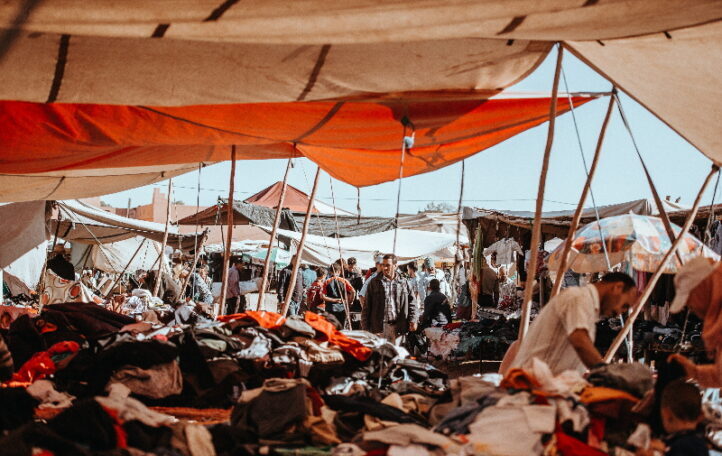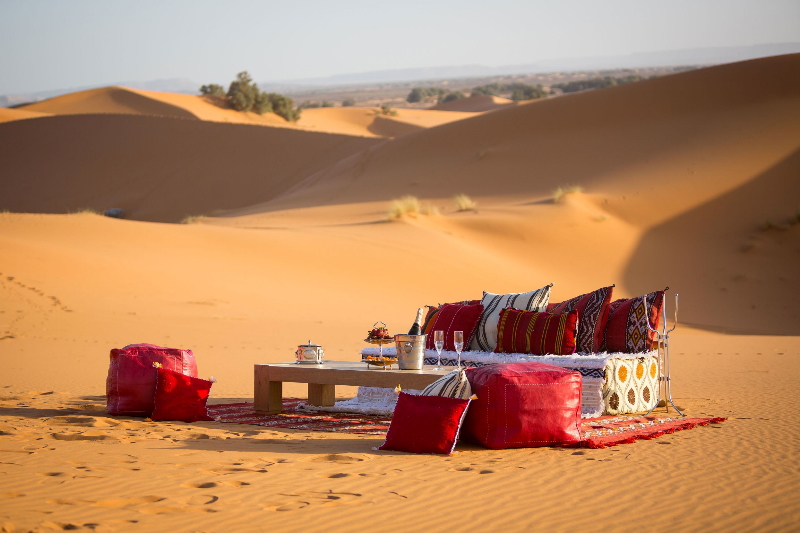Yves Saint Laurent once said that Marrakech had taught him what color was. The famous French fashion designer first visited the “red city” in 1966 with his partner Pierre Bergé. This trip was to change their lives because soon after, they bought a Riad in the Medina, called Dar El Hanch, the house of the snake.
The chaotic world of the Medina, with its tangled alleys, souk, acrobats, snake charmers and dancers, fascinated and inspired St. Laurent, who spent long periods of his life in Marrakech, first in his riad in the Medina, then in a villa in the new city.
The Medina is undoubtedly the heart of life in most Arab cities. Its treasures have been protected for centuries by its thick walls and a chaotic labyrinth of narrow streets, strategically designed so that the enemy would be lost in the event of an attack, but at the same time perfectly organized into orderly neighborhoods specializing in different trades and professions.
In Marrakech, there are large, ornate and finely carved gates that once marked the separation between the different neighborhoods and can still be seen today. Each neighborhood is a real microcosm with a life of its own, where the most important emblems are never missing. The mosque, always close by for the frequent and daily prayers, and its imams reciting the eternal “Allahu Akbar” (God is great), the constant background music throughout Medina. The medersa is like a neighborhood school for children, where they learn not only to recite the holy verses of the Koran but also reading, mathematics, art and the values of coexistence in the Medina. Daily hygiene is fundamental, as the cleanliness of the body is a symbol of the cleanliness of the soul, and as there is no running water in many homes, public baths become an essential routine. It is here, with alternating hours for women and men, that socialization takes place, becoming an important meeting point for social, family and professional relationships. And finally, the neighborhood oven. In the past, houses in the Medina did not have their own oven, and each family took their bread, buns and filled pastries to be baked every day. In many cases, ten percent of the amount was left as payment to the baker. Today, these ovens are still in operation in all the neighborhoods of the Medina.
When the guilds end their day, the Medina is transformed at dusk and people begin to flock gradually to the same place. This is the heartbeat of the Medina before nightfall. The central square Jamaâ El Fna, which is transformed with an explosion of colors, agitation, people and aromas. The heartbeat of the Medina varies according to the time of day or the season of the year. Before sunset, carts overflowing with fresh oranges prepare to quench the thirst of those who have spent the day working in the heat of Marrakech with a freshly squeezed juice. A few hours later, what was once a bustling market of fruits, vegetables, exotic spices, flowers, teas and henna tattoo artists looking for customers, is transformed again. The stalls are being dismantled to make way for portable restaurants. This is the old concept of the “food truck” where a portable kitchen surrounded by large tables and colorful awnings with all kinds of light bulbs hanging from tangled wires, serves food of all kinds. The place becomes a real open-air restaurant that can accommodate hundreds of people who come here after a long day. Here you can taste the famous “pastillas”, one of the oldest dishes combining sweet and salty flavors. They are shaped like a dough made of several layers of thin dough and are filled with poultry, beaten eggs, almonds, onions, sugar, spices and flavored with cinnamon.
Water carriers, who carry and sell glasses of drinking water stored in large metal tanks carried on their backs, add a touch of color. Their elaborate costumes and traditional hats are now the focus of photographers and tourists passing through the area.
But one of the greatest treasures of the square is the appearance of the “halaiqi” or storytellers. The last survivors, they are responsible for perpetuating the craft of oral literature, which has been lost for centuries in Europe, and is based on the tradition of telling magical stories of adventure, travel and unknown worlds in which good always triumphs over evil. Crowds of people form around it, dozens all over the square, each telling a story in chapter form, at the rate of one chapter per day, keeping the audience in anticipation and awe, as each day a new chapter of the story is eagerly awaited. Like a Netflix series, the audience follows their favorite storyteller for weeks until the story ends. Even if you don’t understand the language, the tone of voice, the gestures and the staging are worth it to immerse yourself for a few minutes in the ancient fantasy of the halaiqi stories.
It is no coincidence that UNESCO has declared Jemaâ el-Fna Square in Marrakech a World Heritage Site, not for its architecture or monuments, but because it is one of the few places in the world where the tradition of ancient oral storytelling is still alive.
The hidden treasures of the Medina
The word Riad, which means garden in Arabic, is the name given to the traditional Moroccan house, usually consisting of two or more floors around a courtyard containing a fountain. Riads were the stately homes of the city and belonged to the wealthiest citizens, such as merchants and courtiers.
In accordance with the rules of the Qur’an that beauty is found within and the outside is a source of distraction for the soul, the beauty and wealth of the riads are oriented inward, which also provides privacy for the family and protection from the Moroccan climate. They are characterized by buildings connected by courtyards, almost always landscaped, and by the absence of large windows on the exterior walls. The first building was generally the one where the public life of the family took place, the second where the private and family life was centered, and the third where the servants lived. The soft sound of water trickling in the small fountains or basins of their courtyards is constant. The central garden of traditional riads often has orange or lemon trees and its walls are decorated with plaster and colored tiles.
Today, many of Marrakech’s riads have been converted into luxury hotels where guests can experience the Arabian Nights. One of them is La Sultana, located in the Kasbah district, at the foot of the Saadian tombs, and a few minutes from Jemaâ El Fna square in Marrakech.
In the Mouasine district of the Medina, El Fenn, which means “cool,” is another luxury Riad, characterized by its leather floors, large collection of modern paintings and lush indoor garden. Its rose-lined terrace offers a spectacular view of the Kotoubia Mosque and the Atlas Mountains.


















